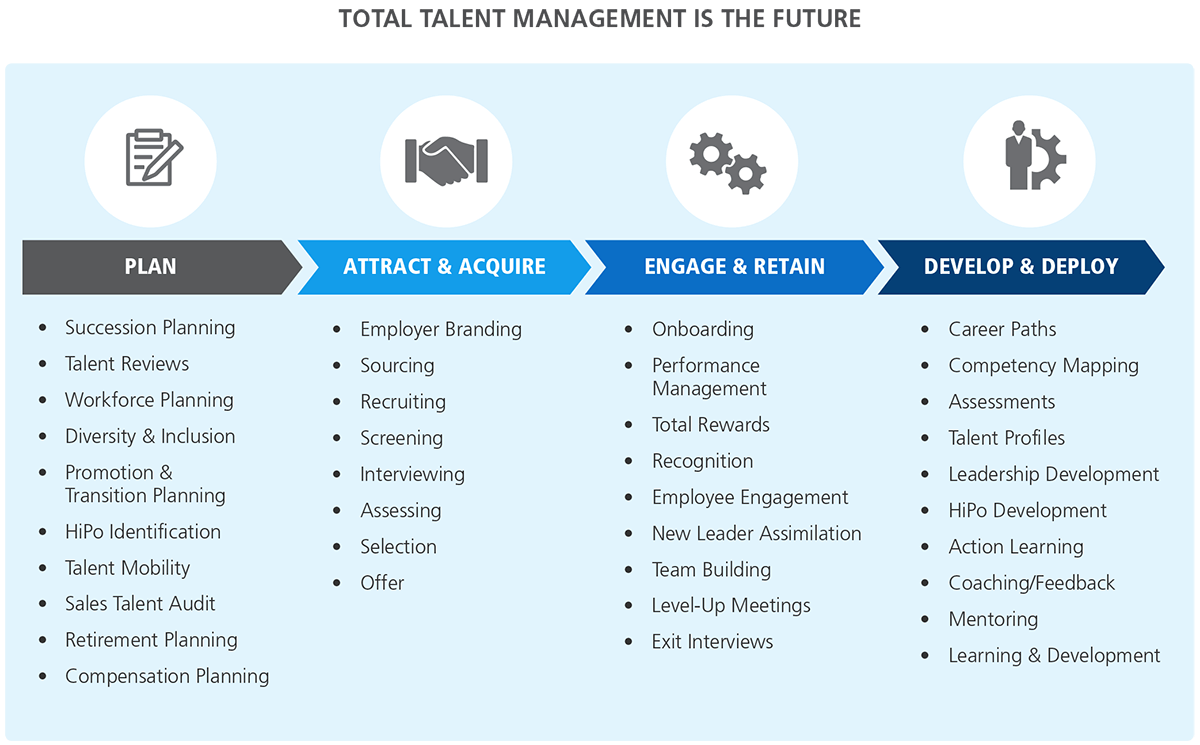Introduction
As of 2015, 30 percent of the Fortune 100 workforce had become contingent; 50 percent of the Fortune 500 workforce will be contingent by 2020.[1] Between 2014 and 2018, the global temporary labor market is expected to grow at a compound annual growth rate (CAGR) of 2 to 3 percent.[2] Estimates are that the U.S. staffing industry will grow to 3.4 million employees by 2020, with $185 billion in temporary labor revenue.[3]
These numbers indicate a shift towards a more flexible, diverse workforce. This means that organizations need to go beyond the idea of a permanent pool of human resources — and manage talent in a more holistic way.
With workforces becoming more diverse and temp labor numbers crossing record figures, Total Talent Management — a model for the acquisition, management, and retention of talent — becomes strategically important, even essential.
This white paper discusses the need for Total Talent Management (TTM) and the role procurement can play in successfully implementing this model. The paper also explains steps procurement can take to optimize the company’s spend on acquiring, managing and retaining human resources.
The Temp Labor Market: Why Are the Numbers Increasing?
The global temp labor market is expected to grow at a CAGR of 2 to 3 percent between 2014 and 2018. In 2013, staffing market sales worldwide amounted to an estimated $416 billion — 75 percent of which was collectively accounted for by the three largest markets: the United States, the European Union, and Japan.[4]
Growth is increasing in developing markets, such as Asia-Pacific (APAC) and Latin America, and steady in North America and Europe. In the U.S., where regulations are less restrictive, staffing industry sales reached a record high of $129.6 billion in 2014; this is estimated to grow at 7 percent in 2015.[5] Staffing agency employment has been one of the fastest-growing sectors in the U.S. for the past few years.[6]
Factors contributing to this growth include the expansion of service lines and geographical presence by temp agencies through mergers and acquisitions, and the increased adoption of technology, social media and the Managed Service Provider (MSP) model by hiring organizations.[2]
Companies have seen the need for temp labor since 1940 when employment models remained open-ended. The 1960s saw the professionalization of temp labor, and temp staffing firms being given employer status — important in the context of the industry today. In the 1970s and beyond, three factors — global competition, the rise of just-in-time (JIT) manufacturing, and the Great Recession of 2008 — drove the temp labor industry to new levels of maturity.
So what’s driving the temp labor market? In today’s economies, the cost of hiring and maintaining full-time employees (FTEs) is increasing. Temp employees may be less expensive FTEs because they only need to deliver their skills on demand, or for an agreed-upon period of time. And in the U.S., the Affordable Care Act (ACA) has made it more profitable for companies — especially those with fewer than 50 FTEs — to maintain temp employees.
Short-term employee demand fluctuations drive temp staffing in a significant way. Temp labor is more likely to be flexible in terms of working hours and wages, and companies get flexibility in hiring. Also, temps reduce the overall liability of a company with regard to their employees.
Data from France, Germany, Sweden, the UK, and the U.S. suggest further reasons for engaging temp labor: the ability to try a candidate before hiring, quicker hiring, access to a larger talent pool, the red tape involved in hiring FTEs, the need to cover short-term FTE leave, and access to extra staff for short-term work peaks.[7]
Workforces worldwide are becoming more focused on personal fulfillment, more mobile — and, therefore, more flexible. For many workers, the ability to easily change jobs or use different skill sets makes temp employment attractive. In Europe, working through a temp agency gives workers more protection than fixed-term employment.[7]
Other trends driving the temp staffing industry include the use of Big Data for culling information about employees and best practices, online labor exchanges, crowdsourcing, and the growth of online staffing. Conservative estimates suggest that the online staffing market will grow 40 percent annually between 2013 and 2020 to reach $16 billion.[7]
The Role of Procurement in Addressing Temp Labor Challenges
For enterprises, the benefits of having a diverse workforce are clear, but the challenges are just as many: reduced control, internal resistance, compliance concerns, information security, and compliance with IP protection. Non-FTEs may be apprentices, paid interns, temp workers, contractors, consultants, or franchisees.
A joint research project by Staffing Industry Analysts (SIA) and ERE Media (ERE) found that the most common categories of non-FTEs were temporary workers and independent contractors or consultants/freelancers (62 percent). Professional services (54 percent) and outsourced services (45 percent) were common.[8]
Talent procurement has played a role in the post-2009 economic recovery, when employers began to demand a more diverse workforce. The so-called “dynamic employee marketplace” has its monetary benefits, but requires employers to plan for employee availability and to understand the true ROI on contingent labor.
In particular, the rise in volume of temp labor means organizations need to manage HR spend in a more holistic way. Challenges toward this include human factors: it is not always easy to get temp employees to be part of a team, and the differences in the management of temp employees vs. FTEs are significant. More significant issues include training costs, the cost of temp employees quitting before project completion, and skill gaps.
Procurement can play a vital role in bridging the issues associated with temp hiring. Traditionally, HR executives have tended to evaluate talent, while procurement agencies have been attuned to finding talent without regard to remuneration, the organization, or the number of FTEs. Staffing agencies need to take on the role of comprehensively evaluating candidates. They must go beyond interviews, verifying candidates’ claimed skills and experience by validating their work history. This helps ensure that temp hires can take on their job roles with minimal training.
Recruiters should evaluate and prepare temp candidates while considering the possibility of their becoming FTEs with hiring organizations. Procurement can add value by increasing its focus on retention, and on the long-term cost benefits of each temp hire. All business functions need to work with HR and procurement to utilize resources internally and seamlessly transition to extending the search for resources outside the organization.
For effective talent acquisition, procurement executives need to develop a strong understanding of labor markets — and adopt an acquisition strategy that ensures alignment with the business goals. Further, they should have an understanding of the hiring organizations’ products and services, as well as their organizational culture — to ensure that prospective hires get an accurate picture of the role they will be fulfilling, which, in turn, leads to better retention. They can use analytics tools to interpret key metrics, such as retention rates and productivity improvements on an ongoing basis. This can help them improve the quality of their hires over time.
The Total Talent Management Approach to Workforce Management
Effective talent acquisition is only one of the challenges associated with temp labor. Employee engagement, management, and retention take on new dimensions when a workforce comprises a significant proportion of temp hires and other contingent workers, especially when they need to work differently in terms of time, collaboration, or level of involvement with the organization.
For example, if a quarter of an organization’s employees have been onboarded by a staffing agency — and are, possibly, working from remote locations — implementing an employee engagement program and measuring its success can be a significant challenge.
Similarly, decisions regarding performance incentives, performance management, and benefits packages become complex when many of an organization’s employees are technically working for a staffing agency. Also, productivity of temp staff tends to be suboptimal if they do not feel they are part of a team that includes FTEs and contract workers.
Ideally, organizations should be able to manage the entire workforce — from talent identification through acquisition to retention and termination — from a single window. The use of Managed Service Providers (MSPs) can be effective to some extent in this regard, but it falls short of providing complete visibility, being able to effectively manage a diverse workforce, identifying real (as opposed to perceived) skill gaps in the organization, and so forth.
The time is right for a Total Talent Management approach to workforce management. We explain TTM by starting with a basic definition: while “talent” refers to the expertise, skill, and knowledge required for a project, “total talent” includes the full range of sources of “talent.”
TTM thus refers to the practice, by an organization, of considering total talent when it comes to talent acquisition or management. This holistic, proactive approach will help organizations better address the pressing challenges that stem from workforce diversity.
TTM provides organizational processes for attracting, managing, and motivating employees in all employment categories. These include performance management, succession management, the development of leadership skills, and training — all from a single interface, and all of which use a common workflow and data platform.
Here is a depiction of the functions involved in a typical TTM implementation:

Let’s look at how the TTM approach to workforce management trumps the traditional.
Addressing talent gaps
In the traditional approach, talent gaps are sensed but not quantified. In fact, they are perhaps not quantifiable for lack of data about project timelines, and often not reported. TTM helps employers optimally fill vacancies, with procurement taking on a larger role in understanding organizational requirements.
Bringing in the right talent
In the search for new talent, segregation of vacancies by engagement level may prevent the right talent from being hired. With the TTM approach, procurement and HR work together to engage talent on whatever terms and timeframes are feasible. A hiring strategy based on TTM drives more informed judgments about which organizational skill gaps need to be addressed, and whether certain positions need to be filled at all. Employers who adopt TTM are also more aware of the skill sets of existing employees.
Motivation and retention
After working for some time in an engagement, new hires often find the terms and conditions not compelling enough for them to stay. Factors such as training and motivation may remain inadequately addressed for the term of the engagement, often leading to suboptimal resource utilization. TTM emphasizes an understanding of all aspects of the employer-employee relationship. A “position to be filled” becomes an organizational skill gap; a “prospective employee” becomes a source of talent to be tapped into in the best manner possible.
Integration
The capabilities and advantages of the TTM approach include the ability to source and on-board FTEs and temp workers using the same process framework, performance evaluations and goal management of FTEs alongside temps, and a collaboration framework where non-FTEs are part of the organization as much as FTEs.[10]
Insights into value
Organizations that adopt TTM will be able to visualize what and who adds value, and what and who merely introduce costs. They will know the true cost of workers; they will be able to gauge parameters, such as optimal remuneration. The traditional view is that temp workers and freelancers have little to contribute to organizational culture. The new, inclusive view looks at what they do have to contribute. It is the responsibility of procurement agencies as well as HR to ensure the success of non-FTEs; this responsibility can be aided via social, video, and other organizational resources.
Insights into performance
In terms of analytics, HR and other executives need insights into high and low performers in an organization are, regardless of employment or engagement status. Delegation and role assignment can depend — if a TTM approach is adopted — on the decisions made on these grounds; “static” approaches cannot help in evaluating performance.
Procurement increases business value
Procurement teams and agencies need to move beyond the traditional perspectives of cost control and “filling in” vacancies. First, they must assess the organization’s current needs as well as business goals from a holistic viewpoint. Next, they will need to maximize the business value of each prospective hire. This requires an understanding of the company’s actual talent shortfalls, a concern for employment timeframes — whether for FTEs or for temps, analysis of the actual level of skill required for a function or project, and the use of tools and services that predict the outcome of a project-hire match.
Intelligent procurement also demands the exploration of non-traditional sources of talent such as labor-ondemand portals, social media, and so forth.
The following Talent Management Continuum presents a holistic view of the states of maturity that organizations will reach as they increasingly adopt a blended workforce composition:
Level 1: Employee-only
Level 2: The use of non-employed workers on an ad hoc basis
Level 3: Multiple worker types with each talent type handled separately
Level 4: Co-existence of worker types based on strategic planning. Managing constructs drive performance enhancement at the organizational level
Level 5: Use of multiple types of talent, and integration of all types in talent acquisition and talent management approaches
Level 6: Proactive integrated thinking, aligned with strategic planning and designed to drive organizational-level performance
Widespread TTM adoption, however, is not likely in the near future. Many organizations are not interested in taking a TTM approach; even if they are, they are unprepared to do so.[10] While the percentage of organizations looking to implement a unified talent management strategy is small today, we can anticipate that HR leaders will likely use such a strategy for FTEs and non-FTEs in the near future.
While there is debate about who has the necessary vision and influence to drive TTM, there is good reason to believe that procurement should take the lead and liaise with HR in a seamless way. Procurement and HR teams are in the best organizational position to make a TTM initiative succeed.
Conclusion
Effective Human Capital Management (HCM) means an organization knows its employees, recognizes the potential of its talent pool, understands the gaps that need to be addressed and the vacancies that need to be filled, performs staffing functions in an optimal way, ensures optimal resource utilization, and encourages and trains workers towards retention of the best talent.
As much as HR, procurement has a major role to play in the understanding of the organization, its needs, and its resources. More than ever before, intervention by HR and procurement can add tremendous business value. TTM ensures visibility into every aspect of the organization/worker relationship.

